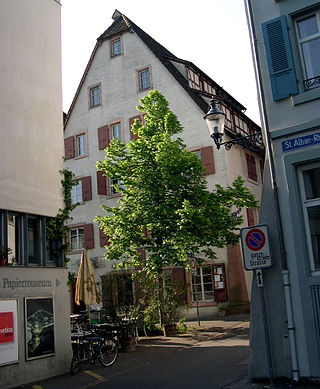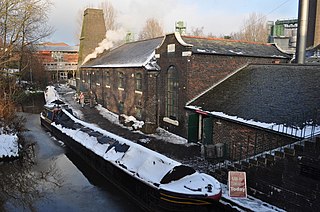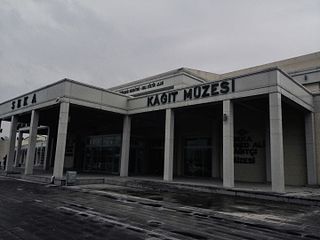
Derwent Valley Mills is a World Heritage Site along the River Derwent in Derbyshire, England, designated in December 2001. It is administered by the Derwent Valley Mills Partnership. The modern factory, or 'mill', system was born here in the 18th century to accommodate the new technology for spinning cotton developed by Richard Arkwright. With advancements in technology, it became possible to produce cotton continuously. The system was adopted throughout the valley, and later spread so that by 1788 there were over 200 Arkwright-type mills in Britain. Arkwright's inventions and system of organising labour was exported to Europe and the United States.

Grimbergen is a municipality in the province of Flemish Brabant, in the Flemish region of Belgium, 10 km (6.2 mi) north of the capital Brussels. The municipality comprises the towns of Beigem, Grimbergen, Humbeek, and Strombeek-Bever. In 2017, Grimbergen had a total population of 37,030. The total area is 38.61 km2 (14.91 sq mi), which gives a population density of 959/km2 (2,480/sq mi).

Halstead is a town and civil parish in the Braintree District of Essex, England. Its population of 11,906 in 2011 was estimated to be 12,161 in 2019. The town lies near Colchester and Sudbury, in the Colne Valley. It is twinned with Haubourdin in the Nord department of France.

Sarehole Mill is a Grade II listed water mill, in an area once called Sarehole, on the River Cole in Hall Green, Birmingham, England. It is now run as a museum by the Birmingham Museums Trust. It is known for its association with J. R. R. Tolkien and is one of only two working water mills in Birmingham, with the other being New Hall Mill in Walmley, Sutton Coldfield.

Verla at Jaala, Kouvola, Finland, is a well-preserved 19th-century mill village. Situated along the northern Kymi River, the mill, nearby power plants, and residential houses were inscribed on the UNESCO World Heritage List in 1996 due to its testimony to the lumber industry in the 19th century and the lives of the industrial workers of that time.

A stamp mill is a type of mill machine that crushes material by pounding rather than grinding, either for further processing or for extraction of metallic ores. Breaking material down is a type of unit operation.

The Grove Park, or The Grove is a public park in Carshalton in the London Borough of Sutton. It is situated close to Carshalton Village in the area approximately bounded by the High Street, North Street and Mill Lane. The southwest corner of the park abuts one of Carshalton's ponds from where water flows through the park as the river Wandle.

The Basel Paper Mill, also known as the Swiss Museum for Paper, Writing and Printing, is a museum located in Basel, Switzerland. The museum is primarily dedicated to the history and techniques of papermaking, and the art of book printing and writing in general. Through a combination of pictures and objects, visitors gain insights into the old artisanal techniques of dipping paper, printing and bookbinding.

Montville is a commune in the Seine-Maritime department in the Normandy region in north-western France.

Collier Memorial State Park is a state park in southern Oregon. The park is operated and maintained by the Oregon Parks and Recreation Department. It is located on U.S. Highway 97, approximately 30 miles (48 km) north of Klamath Falls and 105 miles (169 km) south of Bend. The park covers 146 acres (59 ha) along the Williamson River.
The Neue Welt is a sub-district of Münchenstein, in the canton of Basel-Country in Switzerland.

The Etruria Industrial Museum is located in Etruria, Staffordshire, in England. The museum is a typical and well-preserved example of a nineteenth century British steam-powered potter's mill. It is situated between the Trent and Mersey Canal and the Etruria staircase locks of the Caldon Canal. The museum has a modern entrance building, leading into a Grade II* listed building which was formerly the Etruscan bone and flint mill. The mill is also a scheduled monument.

Queen Street Mill is a former weaving mill in Harle Syke, a suburb to the north-east of Burnley, Lancashire, that is a Grade I listed building. It now operates as a museum and cafe. Currently open for public tours between April and November. Over winter the café is opened on Wednesdays. It is also viewable with private bookings.

The Winooski Falls Mill District is located along the Winooski River in the cities of Winooski and Burlington, Vermont, in the United States of America. It encompasses a major industrial area that developed around two sets of falls on the river in the 19th century.

William Roberts and Company of Phoenix Foundry in Nelson, Lancashire, England, produced many of the steam engines that powered cotton weaving and spinning mills of Pendle and neighbouring districts. Industrial historian Mike Rothwell has called Phoenix foundry “Nelson’s most significant engineering site”.

The Campolmi Factory, the Prato Textile museum and Lazzerini Library is a textile museum and library in Prato in Tuscany, Italy. The museum is an Anchor point on the European Route of Industrial Heritage.

Alfred Hardy (1900–1965) was a Belgian contractor and autodidact architect. He became internationally known for his thin-shell concrete constructions in the 1950s and 1960s.

The SEKA Paper Museum, a.k.a. SEKA Mehmet Ali Kağıtçı Paper Museum, is a museum of industrial heritage in Kocaeli district (İzmit), northwestern Turkey. Situated in a former pulp and paper mill, it is dedicated to papermaking in Turkey. The museum was opened in 2016.

Prinsenkasteel was a castle located in Grimbergen, Belgium. It was the residence of the lords of Grimbergen from the 14th Century onwards. The castle ruins are located in Prinsenbos Park.



















